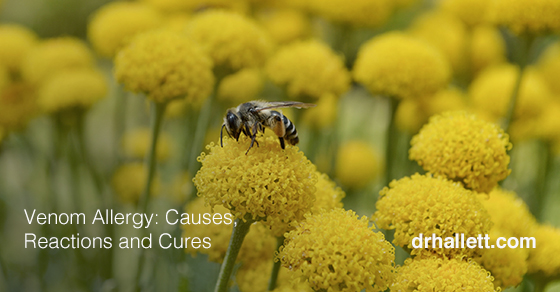
For most of us, an insect sting can cause a little redness, swelling and itching. But for those with a venom allergy, the results can be far different, even potentially fatal. The American Academy of Allergy Asthma and Immunology advises anyone who has had a serious reaction to an insect sting to consult an allergist. He or she can recommend venom allergy immunotherapy to better protect a patient against allergic reactions to stinging insects.
Many insects have been shown to cause allergies, and in more ways than one might expect. In Texas, fire ant stings are of particular concern. Stings expose us to insects’ body parts and bites to their salivary gland secretions. People can even inhale these secretions. The more than 70 families of insects in an order called Hymemoptera are responsible for causing sting allergic reactions. Of those, bees, fire ants and wasps sting people most often. Hornets and yellow jackets are also a concern.
Three Reactions to Insect Stings
People have three very different reactions to Hymemoptera stings. The normal response is the most common, with any redness, swelling or pain confined to a small area. When those symptoms spread, it’s called a large local reaction. These can cover an entire extremity and last up to five days. An allergic systemic reaction, however, can involve the skin, respiratory system and vascular system. It can develop within a half-hour and can be life-threatening.
According to the AAAAI, “Anaphylaxis is a medical emergency and may be fatal. If you have these symptoms after an insect sting, get emergency medical treatment. After this treatment, you should also ask for a referral to an allergist / immunologist, often referred to as an allergist, to learn how to stay safe in the future.”
The Difference Between Suffering and Feeling Better
Even a large local reaction is an indication for allergy testing and the potential use of allergy venom immunotherapy, which is available for fire ant, wasp, honey bee, yellow jacket, and white- and yellow-faced hornets.
Venom injections, which are covered by most insurance plans, are administered in a physician’s office. Patients usually begin with a low dose and low concentration of extract and build up to their maintenance dose over a period of months. Once at a maintenance level, patients continue with injections every two to six weeks.
“With a proper diagnosis, treatment plan and careful avoidance, people with an insect allergy can feel more confident and enjoy being outdoors,” the AAAAI says. “The right care can make the difference between suffering with an allergic disease and feeling better.”
Feel More Confident Outdoors.
“With a proper diagnosis, treatment plan and careful avoidance, people with an insect allergy can feel more confident and enjoy being outdoors,” the AAAAI says. “The right care can make the difference between suffering with an allergic disease and feeling better.” Discover more by contacting by Dr. Hallett today.